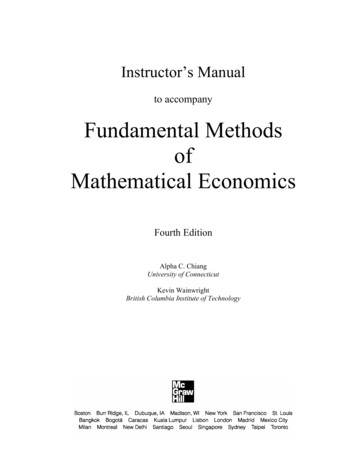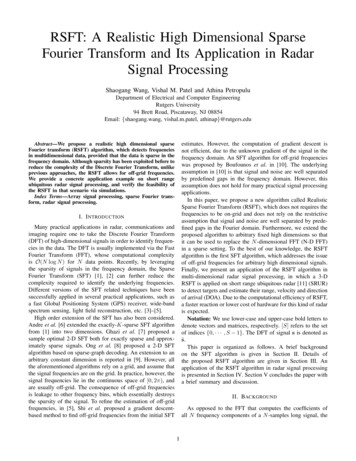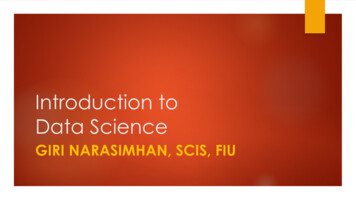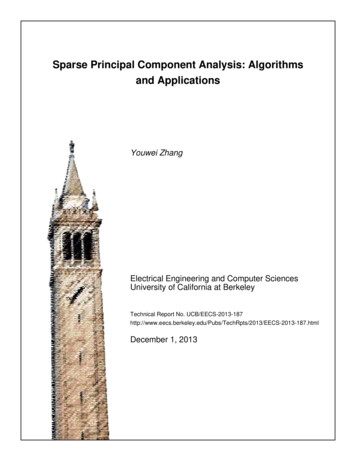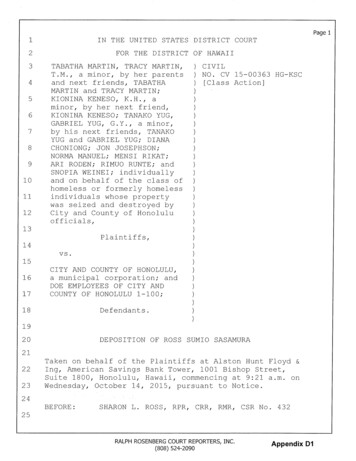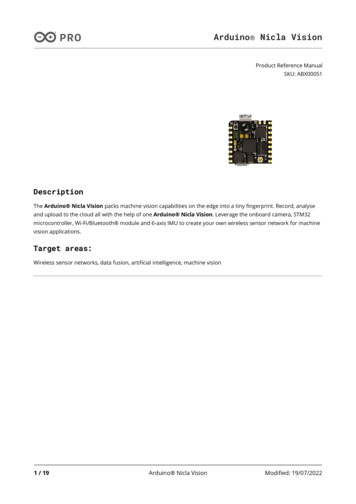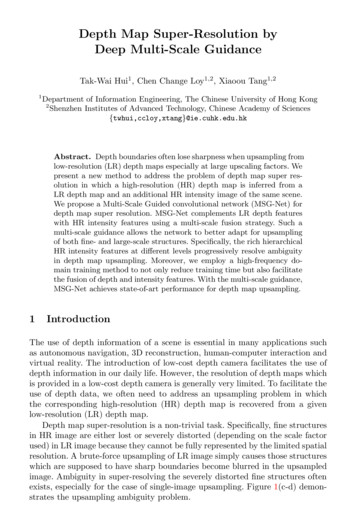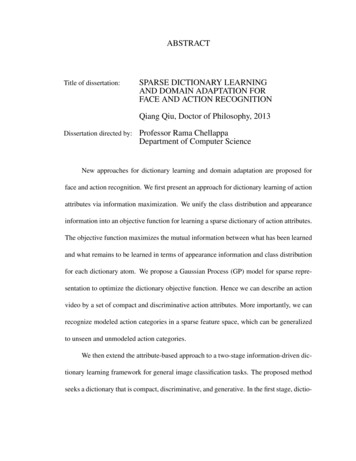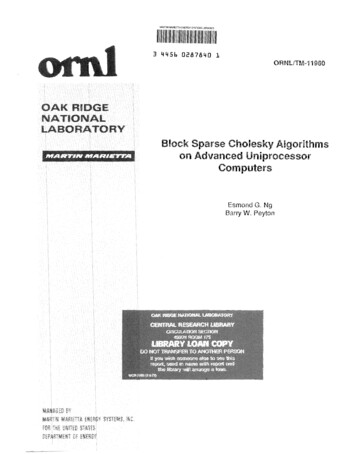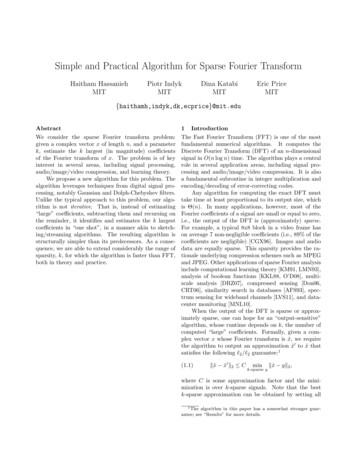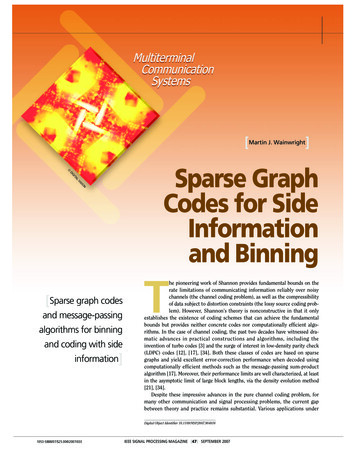
Transcription
[Martin J. Wainwright] ALITGDINOSIVI[Sparse graph codesand message-passingalgorithms for binningand coding with sideinformation]Sparse GraphCodes for SideInformationand BinningThe pioneering work of Shannon provides fundamental bounds on therate limitations of communicating information reliably over noisychannels (the channel coding problem), as well as the compressibilityof data subject to distortion constraints (the lossy source coding problem). However, Shannon’s theory is nonconstructive in that it onlyestablishes the existence of coding schemes that can achieve the fundamentalbounds but provides neither concrete codes nor computationally efficient algorithms. In the case of channel coding, the past two decades have witnessed dramatic advances in practical constructions and algorithms, including theinvention of turbo codes [3] and the surge of interest in low-density parity check(LDPC) codes [12], [17], [34]. Both these classes of codes are based on sparsegraphs and yield excellent error-correction performance when decoded usingcomputationally efficient methods such as the message-passing sum-productalgorithm [17]. Moreover, their performance limits are well characterized, at leastin the asymptotic limit of large block lengths, via the density evolution method[21], [34].Despite these impressive advances in the pure channel coding problem, formany other communication and signal processing problems, the current gapbetween theory and practice remains substantial. Various applications underDigital Object Identifier 10.1109/MSP.2007.9048161053-5888/07/ 25.00 2007IEEEIEEE SIGNAL PROCESSING MAGAZINE [47] SEPTEMBER 2007
codes and associated channel and source coding problems. Wedevelopment—among them, distributed video coding [16], [33],then discuss how coding problems can be represented in termsMIMO communication systems [46], as well as digital waterof sparse graphs and the use of message-passing algorithms formarking and data hiding [11], [29]—require efficient methodsdecoding and encoding in such sparse graphical codes.for various types of coding with side information. Classicalinformation-theoretic solutions to coding with side informationBASIC CHANNEL AND SOURCE CODINGare based on binning, a general procedure that also underliesAny binary linear code C of block length n and ratevarious other communication problems. Given the wealth ofR 1 (m/n) can be specified as the null space (in modulo twoapplications, there is great deal of contemporary interest indeveloping practical codes and computationally efficient algoarithmetic) of a given parity check matrix H {0, 1} m n . If therithms. Although a large number of practical approaches haveparity check matrix is of full rank (m), then the code C consists of2n m 2nR codewords. In the chanbeen proposed, current theoreticalunderstanding of their performancenel coding problem, the transmitterTHERE IS NOW GREATremains incomplete. The commonchooses some codeword x C andINTEREST AND CONSIDERABLEthread tying together these approachtransmits it over a noisy channel, soLITERATURE ON PRACTICALes is the framework of sparse graphicalthe receiver observes a realization of aCODES AND ALGORITHMScodes and an associated set of mesnoisy random variable Y y.sage-passing algorithms for decodingFrequently, the channel is modeled asFOR PERFORMING BINNING.and encoding [17], [20]. These iteramemoryless, meaning that it can betive algorithms, in which neighboringspecified as a factorized distribution P(y x) ni 1 fi (xi ; yi ). As a simple example, in the binarynodes in the graph defining the code exchange information, mayeither be of exact nature, such as the Viterbi algorithm for trellissymmetric channel (BSC), the channel flips each transmitted bitxi independently with some probability p. The goal of the receivercodes, or an approximate nature, such as the sum-product algorithm for LDPC codes.is to solve the channel decoding problem: estimate the most likelyThe purpose of this article is to provide an overview andtransmitted codeword, given by x̂ maxx C P(y x). This decodintroduction to this rapidly developing area of research. Weing task is typically a difficult problem in combinatorial optimizabegin in the following section with a brief introduction to thetion since, in general, it entails searching over an exponentiallybasics of codes defined by factor graphs as well as iterativelarge set of possible codewords. The Shannon capacity of a chanmessage-passing algorithms for solving decoding and encodingnel specifies an upper bound on the rate R of any code for whichproblems. Then we describe the problems of source codingtransmission can be asymptotically error-free. For example, forwith side information (SCSI) and channel coding with sidethe BSC with flip probability p, the capacity is given byC 1 h(p), where h(p) plog 2 p (1 p) log 2 (1 p) isinformation (CCSI) along with their applications to distributedcompression, MIMO communication, and information embedthe binary entropy function.ding. In addition, we discuss the more general notion of binThe goal of source coding, on the other hand, is to compressning, which underlies the classical information-theoretica data source subject to some bound on the amount of distorsolutions to these and related communication problems.tion. To be concrete, one might be interested in compressing aAlthough conceptually appealing, naive random binning issymmetric Bernoulli source, meaning a bit string Y {0, 1}n ,practically infeasible, which motivates the study of structuredwith each bit Y i equally likely to be 0 or 1. Here a natural distorschemes for constructing nested source-channel codes.tion metric would be the Hamming distance d(ŷ, y) 1n ni 1 ŷi yi between a fixed source sequence yAccordingly, the core material in the section following isdevoted to an overview of structured methods for lossy comand the compressed version ŷ. Classical rate-distortion theorypression and binning, with a particular emphasis on the sparsespecifies the optimal tradeoff between the compression rate R,graphical codes studied in our recent work. Next, we discusswhich indexes the number 2nR of possible compressedsome of the algorithmic challenges associated with sparsesequences ŷ, and the average distortion D E[d(Ŷ, Y)], wheregraphical codes. In particular, many problems involving lossythe expectation is taken over the random source sequence Y andcompression and binning appear to require novel messageits compressed version Ŷ. For the symmetric Bernoulli sourcepassing algorithms, related to but distinct from the usual sumconsidered here, this rate-distortion tradeoff is specified by theproduct updates [17], [20]. Given the space constraints of thisfunction R(D ) 1 h(D ), where h is the previously definedarticle, we limit our discussion to simple but intuitively revealbinary entropy function. Given a code C, optimal source encoding examples, mainly involving binary sources and channels.ing corresponds to finding the codeword ŷ C that is closest toHowever, it should be stressed that the basic ideas are morea given source sequence y—namely, solving the combinatorialbroadly applicable to general sources and channels.optimization problem ŷ arg minx C d(x, y).BACKGROUNDThis section is devoted to background material that underliesour discussion. We begin with a brief description of binary linearSPARSE GRAPHICAL CODESBoth the channel decoding and source encoding problems, ifviewed naively, require searching over an exponentially largeIEEE SIGNAL PROCESSING MAGAZINE [48] SEPTEMBER 2007
codebook, since C 2nR for a code of rate R . Therefore, anypractically useful code must have special structure that facilitates decoding and encoding operations. The success of a largesubclass of modern codes in use today—including trelliscodes, turbo codes, and LDPC codes—is based on the framework of factor graphs and message-passing algorithms [17],[20]. Given a binary linear code C, specified by parity checkmatrix H, the code structure can be captured by a bipartitegraph, in which circular nodes ( ) represent the binary valuesxi (or columns of H), and square nodes ( ) represent the parity checks (or rows of H). For instance, Figure 1(a) shows thefactor graph for a rate R 1/2 code in parity check form, withm 6 checks acting on n 12 bits. The edges in this graphcorrespond to 1s in the parity check matrix, and reveal thesubset of bits on which each parity check acts. The code illustrated is regular with bit degree three and check degree six.Such low-density constructions, meaning that both the bitdegrees and check degrees remain bounded independently ofthe block length n, are of most practical use since they can beefficiently represented and stored and yield excellent performance under message-passing decoding. In the context of achannel coding problem, the shaded circular nodes at the topof Figure 1(a) represent the observed variables yi receivedfrom the noisy channel.Trellis codes are another widely used class of codes. Incontrast to the classical trellis representation shown at thebottom of Figure 1(b), the top part shows how a trellis codecan be represented in terms of a linearly ordered factorgraph (i.e., a chain). As we discuss in more detail in the following, the cycle-free structure of this graph is desirablesince message-passing algorithms for decoding/encodingare guaranteed to be exact for such graphs [17], [31]. Notethat, in contrast to the cycle-free structure of the trelliscode in Figure 1(b), the factor graph representing the LDPCcode in Figure 1(a) has many cycles. For such graphs withcycles, message-passing algorithms are no longer exact butnonetheless perform well for many graphs, as we discuss inthe following.MESSAGE-PASSING ALGORITHMSThe significance of codes based on sparse factor graphs is infacilitating the use of message-passing algorithms forencoding and decoding operations. Here we briefly discussof the sum-product and max-product (min-sum) algorithmsfor factor graphs; given space constraints, our treatment isnecessarily superficial, but see the tutorial papers [17], [20]for more detail. In the previous section, we described theuse of factor graphs for representing the structure of a binary linear code. More broadly, one can think of factor graphsas specifying the factorization of some probability distribu tion in the form P X (x) Z1 a C fa(xN(a) ), where C represents the set of factors a in the decomposition, and thefactor fa is a function of the variables in its factor graphneighborhood N(a). As a concrete example, in the case ofbinary linear codes discussed previously, each factor fa cor-responds to an indicator function for the parity check over a particular subset of bits, so fa(xN(a) ) 1 ifi N(a) xi 0,and fa(xN(a) ) 0 otherwise. The constant Z, known as thepartition function, serves to normalize the probability distribution to unity. Observations y, which might either bethe output of a noisy channel or a realization of some datasource, are represented by a conditional distribution PY X (y x) ni 1 fi (xi , yi ) and lead via Bayes’ rule to theposterior distributionP X Y (x y) n 1 fa(xN(a) )fi (xi yi ). Z a Ci 1(1)Given this posterior distribution, the following two computationaltasks are of interest: 1) computing marginal distributions P(xi y)at each node i 1, . . . , n and 2) computing the maximum a posteriori (MAP) assignment x̂MAP : arg maxx PX Y (x y). Notethat when the prior distribution PX is uniform, as in the standardcoding set-up, then the MAP codeword is equivalent to the maximum likelihood (ML) codeword previously defined.The sum-product and max-product algorithms are efficient approaches, based on a divide-and-conquer strategy,for solving the marginalization and MAP problems, respectively. The updates can be cast as message-passing operations, in which nodes adjacent in the factor graph conveythe results of intermediate computations by passing messages (vectors in the case of discrete random variables). In afactor graph, there are two types of messages: variable toy1 y2 y3 y4 y5 y6 y7 y8 y9 y10 y11 5c401(b)[FIG1] (a) Factor graph representation of a rate R 0.5 LDPCcode with bit degree dv 3 and check degree dc 6. (b) Top:Factor graph representation of a trellis code as a chainstructured graph. Bottom part: more standard trellis-diagram,illustrating both the chain structure and the pattern of zerosin the transition diagram.IEEE SIGNAL PROCESSING MAGAZINE [49] SEPTEMBER 2007
a source X up to some distortion constraint, using side information Y available only at the receiver. For instance, in thecontext of distributed compression in a sensor network, theside information represents the compressed information pro vided by adjacent sensors.Mai (xi ) fa(xN(a) )M ja(xN(a) ),andAs a simple but pedagogically useful example, let us supxj j N(a)/ ij N(a)/ i pose that we wish to compress a symmetric Bernoulli sourceMbi (xi ).(2)Mia(xN(a) ) f(xi ; yi )vector X {0, 1}n . As discussed previously, classical rate disb N(i )/atortion theory asserts that the minimum rate required toachieve average distortion D is given by R (D ) 1 h(D ). Inthe Wyner-Ziv extension [42] of this problem, there is an addiThe max-product (or min-sum) algorithm has a very similartional source of side information about the source sequenceform, with the summation in (2) replaced by maximization. ForX—say in the form Y X W, wheregraphs without cycles, also known asW Ber(p) is observation noise—trees, the updates converge after aNOVEL ALGORITHMS AREthat is available only at the decoder.finite number of updates and provideIn this setting, the minimum achievexact solutions [17], [31]. For instance,REQUIRED FOR SOLVINGable rate is essentially specified bywhen applied to the chain-structuredCODING PROBLEMS OTHERthe curve Rwz h (D P) h(D),factor graph in Figure 1(b) associatedTHAN CHANNEL DECODING.with a trellis code, the min-sum algowhere D p D(1 p) (1 D ) p isrithm is equivalent to the Viterbi algothe binary convolution. [Strictly speakrithm, and will compute the most likely configuration (oring, the Shannon limit is given as the lower convex envelope ofshortest trellis path) in a finite number of steps. However, thesethis function with the point (p, 0).] In comparison with the stanalgorithms are also frequently applied to graphs with cycles, fordard rate-distortion function R(D ) 1 h (D ), we see that thewhich they are no longer exact but rather approximate methods.value of the side information is measured by the gap betweenh (D p) and 1, with equality for p 1/2 corresponding to useNonetheless, for certain classes of graphs with cycles (e.g., thosecorresponding to LDPC codes with large block lengths), the perless side information.formance of these approximate message-passing schemes fordecoding is excellent, as substantiated by both empirical andCHANNEL CODING WITH SIDE INFORMATIONtheoretical results [34].The problem of CCSI takes a symmetric form with respect theencoder and decoder roles: here the side information is availBEYOND THE BASICS: CODING WITHable only at the encoder, and the goal is to perform (almost)SIDE INFORMATION AND BINNINGas well as if the side information were available at both theMany problems in communication and signal processing requireencoder and decoder. One variant is known as the Gelfandcoding approaches that go beyond channel or source codingPinsker problem [15]. Given an input vector U, the channelalone. Important examples include the problems of source codadds to it some fixed host signal S and possibly adds a noiseing with side information (SCSI) at the receiver, and the probterm as well. Even though the encoder knows the host signalS, it cannot simply cancel this known interference (i.e., tidylem of CCSI at the transmitter. In this section, we begin with abrief description of these problems, and their significance in varup the dirty paper [9]) due to some form of channel constraintious applications. We then discuss the more general notion ofon the average transmitted power. This class of models probinning, which is the key ingredient in the information-theoretvides an appropriate abstraction for various applications,ic solutions to these problems.including the problem of coding on defective memory cells,problems in digital watermarking and steganography, andLOSSY SOURCE CODING WITH SIDE INFORMATIONMIMO communication. The papers [2], [5], [29], and [46] andIt is often desirable to perform joint compression of a collectionreferences therein contain further background on the probof dependent data sources. Without any constraints on commulem and these applications.nication between the sources, one could simply pool all of theAs an illustrative example, let us formalize the special casedata into a single source and apply standard compression methof coding on binary dirty paper, also known as binary informaods to this pooled source. However, many applicationtion embedding. More specifically, suppose that for a givendomains—among them sensor networks [43] and distributedbinary input U {0, 1}n , the channel output takes the formY U S Z, where S {0, 1}n is a host signal (not undervideo coding [6], [16]—require that compression be performedin a distributed manner, without any communication betweencontrol of the encoder), and Z Ber(p) is a channel noisethe sources. In the information theory literature, one version ofvector. Typically, the host signal S is modeled as a realizationlossless distributed compression is the Slepian-Wolf problemfrom some stochastic model (e.g., a symmetric Bernoulli[37]. Here we focus on the Wyner-Ziv extension to lossysource). The encoder is free to choose the input vector U, subSCSI[42], in which the goal is to perform lossy compression ofject to the average channel constraint E[ U 1 ] δn, so as tocheck messages (Mia ) and check to variable messages (Mai ).In the sum-product algorithm, these messages are updatedaccording to the recursive equationsIEEE SIGNAL PROCESSING MAGAZINE [50] SEPTEMBER 2007
maximize the rate of information transfer. Conceptually, it isuseful to write U UM , where M is the underlying messagethat is embedded, and note that the decoder’s goal is to recover this embedded message M from the corrupted observationY. The capacity in this set-up is essentially determined by thecurve RIE (δ, p) h(δ) h(p). [To be precise [2], the Shannonlimit is specified by time-sharing between the curve R IE andthe point (0, 0).] As one special case, note that when δ 1/2,the channel input constraint E[ U 1 ] n/2 effectively playsno role, and the information embedding capacity reduces tothe classical capacity C 1 h(p).BINNING SOLUTIONSThe term binning refers to a standard information-theoreticapproach to proving capacity results for coding with sideinformation, as well as related multiterminal problems [9],[15], [33], [42], [46]. To illustrate the basic idea, let us consider the binary information embedding problem describedpreviously but with no channel noise ( p 0). In this specialcase, the problem is one of constrained channel coding—howto transmit information over a channel that maps a binaryinput input U {0, 1}n to a binary output Y U S subjectto the average input constraint E[ U 1 ] δn. Note that thecurve R IE reduces to h(δ) when p 0. If the host signal werealso known at the decoder, , then it would be straightforwardto achieve the rate h(δ) by the following procedure. First, theencoder chooses a binary sequence M {0, 1}n with δn ones. n The number of such sequences is δn, which by Stirling’sapproximation to factorial coefficients scales as 2nh(δ) . Theencoder then simply transmits U M, which satisfies thechannel input constraint. In the second step, the decoderreceives Y M S, and given knowledge of the host signalS, it recovers the message M by a simple XOR operation.The overall transmission rate for this scheme is n (1/n) log δn hδ, and it is the best that can be achieved.What approach should be taken when the host signal S isnot known at the decoder? Simply attempting to cancel outthe host signal at the encoder (by transmitting U M S) isnot an option, since the sequence M S fails to satisfy thechannel input constraint. Although this naive approach fails,the remarkable phenomenon is that even when the decoderdoes not know the host signal, the optimal rate h (δ) can beachieved by a binning strategy. For this problem, the binningstrategy is to partition the set of all 2n binary sequences into a n 2nh(δ) bins. Figure 2(a) provides a toytotal of B : δnillustration of this binning procedure, where the set of all circular nodes (representing all 2n possible binary sequences)are partitioned into B 3 bins.Both the encoder and decoder are given knowledge of thepartition, and the message vectors M are used to index thebins. The encoder proceeds as follows: in order to transmit aparticular fixed message M, it restricts itself to the binindexed by M [see Figure 2(b)], and searches for a codewordŜM that differs from the host signal S in, at most, δn positions. Each randomly constructed bin contains approximately2n/B 2n[1 hδ ] elements and so can be viewed as a sourcecode with rate R 1 hδ. In fact, the scheme requires thateach bin on its own acts as a good source code for quantizingup to average distortion D. Under this assumption, standardrate-distortion theory guarantees that it will be possible toquantize the host S such that the average distortion satisfiesE[d(ŜM , S)] δn. The encoder then transmits the quantization error EM : S ŜM , which satisfies the channel inputconstraint by construction. Finally, the encoder receivesY EM S ŜM , on which basis it can identify the messageM uniquely specified by the codeword ŜM .Note this binning scheme can be viewed as a collection of2nh (δ) source codes for quantizing the host signal, all nestedwithin the full space of 2n binary strings. In order to solve themore general information embedding problem with channelnoise p 0, it is necessary to partition a good channel code(with 2n[1 H(p)] codewords) into a collection of good sourcecodes. Conversely, for the dual problem of source coding withside information, one requires a good source code that can bepartitioned into good channel codes [42], [46]. However, thepreceding discussion has been rather idealized, in that it isbased on completely unstructured codes and bins, and providesno concrete construction of such nested codes. Accordingly, thefollowing section is devoted to structured and practicalapproaches based on sparse graphical codes for constructingsuch nested source-channel codes.PRACTICAL CONSTRUCTIONS AND ALGORITHMSWe now turn to an overview of practical constructions and algorithms, beginning with the simpler problem of lossy compression, before moving onto practical codes for binning and codingwith side information.(a)(b)[FIG2] Illustration of binning for binary information embedding.(a) The original set of binary strings is partitioned into a set of Bbins (B 3 in this diagram, with white, grey and black nodesrespectively). Each bin on its own is required to be a good sourcecode, meaning that it can be used to quantize the host signal Sup to average Hamming distortion δn. (b) The message Mspecificies a particular bin (in this case, the bin with black nodes);the message is transmitted implicitly, by using the chosen bin asa source code to quantize the host signal S (square) by thenearest codeword ŜM , and transmitting the quantization errorEM : S ŜM .IEEE SIGNAL PROCESSING MAGAZINE [51] SEPTEMBER 2007
PRACTICAL CODES FOR LOSSY COMPRESSIONFor problems of lossless compression, the use of practical codesand algorithms is quite well-understood, both for standard lossless compression [4], [14], [33] and for Slepian-Wolf type extensions [13], [33], [35]. Many lossless problems can be convertedinto equivalent channel coding problems (e.g., via syndromeforming procedures), which allows known constructions andmethods from channel coding to be leveraged. For lossy compression, in contrast, the current gap between theory and practice is more substantial.The class of trellis codes provides one widely-used methodfor lossy compression [23], [39]. As illustrated in Figure 1(b),a trellis code can be represented as a chain-structured factorgraph, which allows encoding/decoding problems to be solvedexactly via the sum-product or max-product algorithms. Thecomplexity of these message-passing algorithms is linear inthe trellis length but exponential in the trellis constraintlength. When used for lossy compression, the shaded nodes atthe top of Figure 1(b) represent the incoming stream ofsource symbols (y 1 , y 2 . . . , etc.). Note that these source symbols align with the edges in the trellis diagram shown inFigure 1(b). The distortion metric is used to assign weights tothe edges of trellis diagram, and the minimum-distortiony1y2y3y4y5y6y7y8y9 y10 y11 500 0.1 0.2 0.3 0.4 0.5 0.6 0.7 0.8 0.9 1Rate(b)[FIG3] (a) Factor graph representation of a low-density generatormatrix (LDGM) code with n 12, m 9 and rate R 0.75. AnLDGM code has bit and check degrees bounded independently ofblocklength; for this example, dc 3 and dv 4. (b) Plots of theeffective rate-distortion function of several finite degree LDGMensembles in comparison to the Shannon bound, obtained usingthe second moment bound (3).encoding, or equivalently the shortest path through the trellis, with edge lengths corresponding to distortion, can then becomputed exactly by running the min-sum algorithm (see[23] for details). Various researchers have demonstrated thepractical utility of trellis codes for single-source and distributed compression [6], [41] as well as for information embedding problems [5], [10]. In terms of theoretical guarantees,trellis-based codes can saturate the rate-distortion bound ifthe trellis constraint length is taken to infinity [39]. This constraint length controls the cardinality of the hidden randomvariables, represented by diamonds in Figure 1(b); in particular, the cardinality of these random variables, and hence thecomputational complexity of the Viterbi algorithm, growsexponentially in the constraint length. Consequently, provablyachieving the rate-distortion bound using trellis codesrequires increasing computational complexity [39], even withoptimal encoding and decoding.Given the limitations of trellis-based approaches, a parallelline of recent work has explored the use of low-density generator matrix (LDGM) codes for lossy compression [7], [27], [30],[40]. The class of LDGM codes is closely related to but distinctfrom the class of LDPC codes. As opposed to a parity check representation, an LDGM code of rate R m/n is described by asparse generator matrix G {0, 1}n m . For instance, Figure3(a) shows a LDGM code with n 12 code bits arranged acrossthe top row, and m 9 information bits along the bottom row,corresponding to an overall rate R 0.75. When used for lossycompression, say of a binary sequence y {0, 1}n , source decoding using an LDGM code is very simple. For a given informationsequence ẑ {0, 1} m , the associated source reconstructionŷ {0, 1}n is obtained by the matrix-vector product ŷ Gẑ,performed in modulo two arithmetic. On the other hand, thesource encoding step is, in general, nontrivial, since it requiressolving the optimization problem ẑ arg minz {0,1} m d(Gz, y)for the given distortion metric d.Focusing on an idealized compression problem known asbinary erasure quantization, Martinian and Yedidia [27] showedthat LDGM codes combined with modified message-passing cansaturate the associated rate-distortion bound. This approach wassubsequently extended to a capacity-achieving scheme for thedeterministic broadcast channel [8]. Another line of research,using techniques from both statistical physics [7], [30] andprobabilistic combinatorics [25], [26], has focused on the fundamental performance limits of sparse LDGM codes for compression of binary symmetric Hamming sources. To provide a flavorfor such results, Figure 3(b) plots some rigorous bounds on theeffective rate-distortion performance of LDGM code ensemblesformed by having each of the n checks choose at random a set ofdc information bits. [The code in Figure 3(a) corresponds to thecase dc 3.] For a given R [0, 1],, the curve is an upperbound on the average Hamming distortion D incurred by thegiven code famil, when encoding and decoding are performedoptimally. Figure 3(b) shows curves for degrees dc {3, 4, 6};note how these effective rate-distortion function approaches theShannon limit as the degree dc increases.IEEE SIGNAL PROCESSING MAGAZINE [52] SEPTEMBER 2007
The curves in Figure 3(b) are derived using the first- and second-moment methods [1], as applied to the random variableN N(Y) that simply counts the number of codewords thatachieve distortion D for a given source sequence Y. Note thatthe code achieves distortion D for source sequence Y if and onlyif {N(Y) 0}. To study the probability of this event, we makenote of the upper and lower bounds(E[N ])2E[N 2 ](a )(b ) P [N 0] E[N ].(3)The first-moment upper bound (a) is simply a form of Markov’sinequality, whereas the second-moment lower bound (b) follows by applying the Cauchy-Schwarz inequality. (In particular,we have E[N ] E[N I(N 0)] E[N 2 ] P[N 0].) For asymmetric Bernoulli source, it is straightforward to show thatfor any code of rate R, regardless of its structure, the firstmoment E[N ] scales as 2n(R 1 h(D)) . Consequently, by thefirst moment upper bound (3)(a), we recover Shannon’s ratedistortion bound for a symmetric Ber
codes and associated channel and source coding problems. We then discuss how coding problems can be represented in terms of sparse graphs and the use of message-passing algorithms for decoding and encoding in such sparse graphical codes. BASIC CHANNEL AND SOURCE CODING Any binary linear code C of block length n and rate
